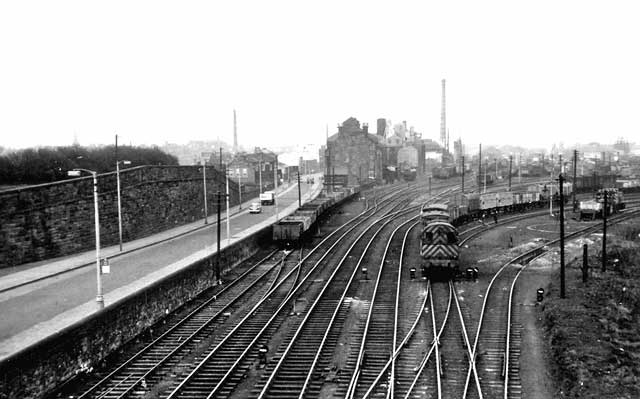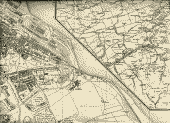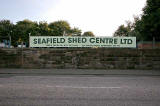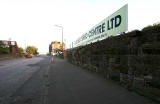|
Railway at Seafield Leith Docks |
View to the west towards Leith from the bridge over the railway at Seafield
© Reproduced with acknowledgement to Douglas Yuill Photographer not known
|
1960s Last Steam Trains in the Edinburgh Area excluding the later age of preserved steam trains |
|
Thank you to James McEwan who left a message in the EdinPhoto guest book. James wrote: Seafield "I was fascinated to view the photos taken at Seafield Road level crossing Edinburgh in the steam era. In 1968 I was working at British Road Services in Seafield Road, long gone and now the home of Allied Carpets. To the rear of the transit shed ran a spur from Meadows signal box over Craigentinny Avenue North, to South Leith goods yard. In November of that year, I witnessed one of the last movements by British rail steam. From memory, I'm certain the locomotive was an 0-6-0, possibly a J36. It was heading a mixed train of goods vans and mineral wagons in the direction of Kings Road where the branch rejoined the line from Leith Docks." James McEwan: Edinburgh, September 18, 2008 |
|
Questions Please scroll down to read these questions and answers |
|
|
Question 1 |
When was last siting of steam in Edinburgh area? |
|
Question 2 |
Was there a bridge over Seafield Road? |
|
Question 1 |
|
James added: "Can any reader recall any later sightings of steam in the Edinburgh area? If so, please email me." James McEwan: Edinburgh, September 18, 2008 |
|
Question 1 Answer 1 |
|
Thank you to Patrick Hutton, New Town, Edinburgh for providing the following details. They suggest that James McEwan's sighting of the steam train at Seafield would have been a little earlier than 1968. Patrick says "Perhaps James is thinking of November 1966. The last scheduled steam in the UK was Carnforth/Settle in August 1968. Patrick added "1. The sleeve for the DVD 'Railways of Scotland: Volume 10 - Glasgow Part Two' refers to 1966 as 'the last year of steam'. (Perhaps this quote refers to the Glasgow area. - Peter Stubbs.) 2. Here is an extract from a page about class J35 and J36 steam locomotives, taken from the LNER Encyclopaedia web site: 'British Rail moved many of the J36s to ex-LMS sheds and ex-GNS sheds, where they tended to work on coal and local freight duties respectively. The J36s managed to out-survive the larger and younger J35s due to their small size which made them ideal for light branch lines. Six were still busy at work in May 1966, and the last was finally withdrawn in 1967.' LNER Encyclopaedia web site" Patrick Hutton, New Town, Edinburgh: September 19, 2008 |
|
Question 1 Answer 2 |
|
Thank you to Patrick Hutton, who wrote with further thoughts: Steam Trains "One thing that occurred to me afterwards was that the steam engine might have been towed, dead, for scrap. It's possible that South Leith yard had been used for dumping locomotives awaiting scrapping, but not very likely as both Seafield sheds were long-closed by then, and scrapping tended to be done quickly. It's quite clear that the last revenue steam working (as opposed to excursions, preservation, etc) was March 1967 |
|
Patrick added Seafield "The goods yard to the South of Seafield Road/Salamander Street, closed on December 31, 1973. It was originally named South Leith, but then renamed Leith East in April 1952. Seafield shed closed in 1962. I'm not sure when South Leith shed closed. It's very confusing, as Seafield shed lay beside, but to the north of, South Leith shed It was accessed by the bridge over Seafield Road that can be seen behind the footbridge in this photo. To get from one shed to the other required travelling up one branch to the junction and back down the other." |
|
Patrick Hutton, New Town, Edinburgh: September 19, 2008 |
|
Question 1 Answer 3 |
|
Thank you to Steve Chambers who added: Class J36 Engines "Like Patrick Hutton, I think that James McEwan is more likely to have seen a J36 in November 1966 than 1968. The last 3 British Railways J36 engines survived into 1967 - 65234 of St Margaret's was sold for scrap on 29.7.67 - 65288 of Dunfermline was condemned on 5.6.67 - 65345 of Thornton was sold for scrap on 15.9.67 A few more J36 engines had survived into 1966 before being scrapped. They were: - 65319 of St Margaret's - 65267, 65282 and 65297 of Bathgate shed. Loco 65327 in Douglas Hume's April 1963 photograph (above) was scrapped in July 1966. The only survivor, 65243 'Maude' was sold to the SRPS (then at Falkirk) in November 1966." Steve Chambers, October 11, 2008 (Source: Yeadon's Register Vol 26) |
|
Question 1 Answer 4 |
|
Thank you to George Renton who wrote: Seafield "Could it be that the J36 locomotive that James Mc Ewan saw from the British Road Services garage was going to the Bernard Hunter scrap yard at the east end of Leith Docks? George Renton, Mississauga, Ontario, Canada: December 27, 2008 |
|
Question 2 |
|
Bob Orr writes: Seafield Road "Iím interested in finding out if the line that went through Craigentinny to Leith East (south of Salamander Street) ever crossed Seafield Road into the main dock sidings. The line was known as the New Lines and was built by the Caledonian Railway at the turn of the last century to gain access to the eastern docks which were dominated by the North British Railway. The Ordnance Survey maps Iíve seen all show a viaduct across Seafield Road, but I have found no reference to it in any history book. David Thomasí 'Forgotten Railways: Vol. 6 Scotland' says that the line never made into the eastern docks proper, but ends rather pathetically at Leith East in a single good shed A survey of the sandstone abutments at Seafield Cemetery gives no clues to a bridge over Seafield Road. Iíd be most grateful to have this mystery solved." Bob Orr, Leith, Edinburgh: August 23, 2009 |
|
If you can help to answer Bob's question, please email me, then I'll pass your message on to him. Thank you. - Peter Stubbs: August 25, 2009 |
|
Question 2 Answer 1 |
|
Thank you to Patrick Hutton who wrote: Seafield Bridge "Bob Orr's question was (indirectly) answered in my comment of 19 Sept 2008 in the same thread. The continuation of the Caley New Lines bridge over Seafield Road can be seen behind the footbridge in the photo of 65327 at Seafield level crossing. The Caley lines ran across the NB lines on a long bridge, and then down an embankment to Seafield shed. Bob is right though, in that the present parapet of the Caley Lines retaining wall doesn't show where the viaduct came out. I think it was just east of that, maybe where the wee yard that Xmas trees are sold from." Patrick Hutton, New Town, Edinburgh: August 26, 2009 |
|
Question 2 Answer 2 |
|
Thank you to Douglas Beath who wrote: Seafield Bridge "I remember the bridge that carried the ex-Caledonian Railway over both Seafield Road and the parallel ex-North British line to reach Leith Docks south end. It was a substantial, red, stone and steel structure matching others on the C.R.'s Leith East branch from Newhaven Station (at Trinity Academy). It was a late-built line (c.1900) and although some station platforms were laid out, there was never a passenger service. The bridge shows on EdinPhoto's Leith Links 1940 map. (It is on the right-hand edge of this map, about 1/3 of the way down. - Peter Stubbs) I would not be surprised if there's no trace of the long earth ramp on the docks side: reclamation fill on their own doorstep!" Douglas Beath, Burnie, Tasmania, Australia: August 26, 2009 |
|
Question 2 Answer 3 |
|
Thank you to Bob Orr who wrote: Seafield Bridge "Thank you to both Patrick Hutton and Douglas Beath. It was too much to think that OS maps would be wrong. And it explains something about the configuration of the line south of Seafield Road (Patrickís remark about the Xmas tree yard) in as much as the overbridge is remarkably low, too low for current day traffic. Thank you also for the 1940 edition of the map. I havenít seen that one before. It looks like some of the history books I have read will have to rewritten!" Bob Orr, Leith, Edinburgh: August 28, 200 |
|
Question 2 Answer 4 |
|
Thank you to Bob Orr who wrote: Seafield Bridge "Thank you to both Patrick Hutton and Douglas Beath. It was too much to think that OS maps would be wrong. And it explains something about the configuration of the line south of Seafield Road (Patrickís remark about the Xmas tree yard) in as much as the overbridge is remarkably low, too low for current day traffic. Thank you also for the 1940 edition of the map. I havenít seen that one before. It looks like some of the history books I have read will have to rewritten!" Bob Orr, Leith, Edinburgh: August 28, 2009 |
|
Question 2 Answer 5 |
|
Thank you to Keith Bathgate who gave more details about the lines in the Seafield area. Keith wrote LMS Leith New Lines "The former Caledonian Railway/LMS ĎLeith New Linesí branch from Newhaven Junction on the Leith North line split into two at Seafield Junction, on the embankment just south of Seafield Road. - One line went to South Leith goods depot on Salamander Street (renamed Leith East by British Railways in 1952 to avoid confusion with the nearby former North British Railway/LNER depot) - (contrary to what the book may say) the other line crossed Seafield Road on a bridge to reach Seafield Yard and the docks." LNER Line built "During World War 2 a new line was built from Meadows Yard on the LNER Leith South branch to Seafield Junction in order to allow LNER trains to access the LMS sidings at Seafield Yard, by way of this bridge." LMS Lines closed "The Leith New Lines branch closed between Newhaven Junction and Leith Walk West goods depot on 4 January 1966, and the line over Seafield Road between Seafield Junction and Seafield Yard closed on the same day. LNER Lines realigned then closed "At this time the line from Meadows Yard was realigned to give access to Leith East (previously it only connected with the Seafield line), and the line from Seafield Junction to Leith Walk West was then worked as a branch from Meadows Yard with a reversal at Leith East. This arrangement only lasted until 6 May 1968 when the line from Seafield Junction to Leith Walk West good depot closed. The last remnant from Meadows Yard to Leith East goods depot closed on 31 December 1973. There is now no trace of the bridge over Seafield Road." Keith Bathgate: September 24, 2009 |
| Meadows Yard that Keith Bathgate refers to in the last of his four paragraphs above was, in fact re-maimed Craigentinny Yard. It appears as Craigentinny Yard in the lower-right corner of this 1925 map: |
|
Question 2 Answer 6 |
|
1940 Map Douglas Beath mentioned (in 2 above) that the bridge over Seafield Road can be seen on this Leith Links extract from of 1940 map of Edinburgh: |
|
1925 Map In fact, the layout of the lines and the bridge over Seafield Road can be seen on this NE Edinburgh extract from a 1925 map. Seafield Road can be seen extending most of the way from the centre of this map to the lower-right corner. The road becomes a little indistinct near the middle of the map, but the line that crosses the road can be clearly seen. It is the only section of railway line that heads north-south on this extract from the map. The bridge is fairly close to the centre of this map: - just above the words 'Seafield Lo" and - to the right of the words "SEAFIELD CEMETERY" |
|
The Bridge I visited Seafield recently and found what I believe may well be the base of the bridge over Seafield Road. It is a small section of wall (about 16 yards long) below the 'SEAFIELD SHED CENTRE LTD' sign in the photos below. It is situated about 50 yards to the west of the footbridge over the railway beside Seafield level crossing, and juts out into the pavement a few inches more than the rest of the wall. |





